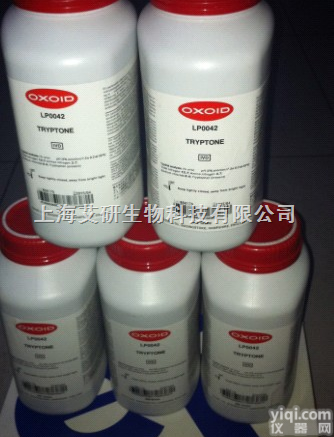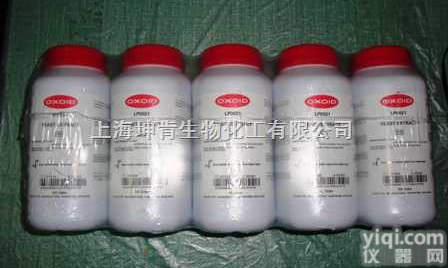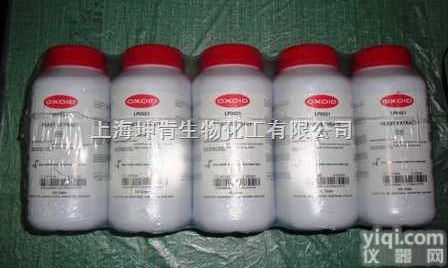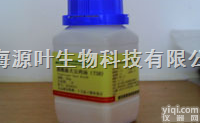显色培养基,用于区分在泌尿道感染发现的细菌
Brilliance™ UTI Agar (formerly Chomogenic UTI Agar ) is a chromogenic medium for the presumptive identification and differentiation of all the main micro-organisms that cause urinary tract infections (UTIs).
Products available | | Size/format | order code |
| Dehydrated Culture Media | 500g | CM0949B |
| Ready-Poured Plates (UK) | 10 x 90mm plates | PO0794A |
| Ready-Poured Plates (rest of Europe) | 10 x 90mm plates | PO5120A |
| Typical Formula* | gm/litre |
| Peptone | 15.0 |
| Chromogenic mix | 26.3 |
| Agar | 15.0 |
| Final pH 6.8 ± 0.2 @ 25°C | |
* Adjusted as required to meet performance standards
Directions
Suspend 56.3g of Brilliance UTI Agar in 1 litre of distilled water, mix well and sterilise by autoclaving at 121°C for 15 minutes. Cool to 50°C and mix well before pouring plates.
Description
Brilliance UTI Agar contains two specific chromogenic substrates which are cleaved by enzymes produced by Enterococcus spp., Escherichia coli and coliforms. In addition, it contains phenylalanine and tryptophan, which provide an indication of tryptophan deaminase activity, indicating the presence of Proteus spp., Morganella spp. and Providencia spp. It is based on electrolyte deficient CLED Medium which provides a valuable non-inhibitory diagnostic agar for plate culture of other urinary organisms, whilst preventing the swarming of Proteus spp.
One chromogen, X-Gluc, is targeted towards β-glucosidase, and allows the specific detection of enterococci through the formation of blue colonies. The other chromogen, Red-Gal, is cleaved by the enzyme β-galactosidase which is produced by Escherichia coli, resulting in pink colonies. Any uncertainty in identification may be resolved by removing suspect Escherichia coli colonies from the plate and performing an indole test using DMACA reagent. Cleavage of both chromogens occurs in the presence of coliforms, resulting in purple colonies (see Table 1).
The medium also contains tryptophan which acts as an indicator of tryptophan deaminase activity, resulting in colonies of Proteus, Morganella and Providencia spp. appearing brown.
Table 1: typical colour reactions
| Organism | β-galactosidase | β-glucosidase | Tryptophan deaminase (TDA) | Colony colour |
| Enterococci | | + | | Blue |
| Escherichia coli | + | | | Pink |
| Coliforms | + | + | | |
| Proteus
Morganella
Providencia | | | + | Brown |
| Pseudomonas | | | | Fluorescent brown or green |
| Staphylococcus | | | | Normal
pigmentation |
Storage and Shelf life
Dehydrated Brilliance UTI Agar must be stored tightly capped in the original container at 10-30ºC.
Oxoid Brilliance UTI Agar plates should be stored in the original packaging, at the temperature stated on the pack or product specification, and protected from direct light.
When stored as directed, the unopened product will remain stable until the expiry date on the label. Locally prepared media can be stored for up to 2 weeks when made from CM0949 according to the manufacturer’s instructions and stored at 2-8ºC, in the dark. A longer shelf life may be attainable, but should be validated under the relevant, local manufacturing and storage conditions.
Appearance
Dehydrated medium: straw coloured, free-flowing powder
Prepared medium: pale buff coloured gel
 显色泌尿道感染培养基(Chromogenic Urinary Tract Infection M.)
显色泌尿道感染培养基(Chromogenic Urinary Tract Infection M.)
 100份/盒 金黄色葡萄球菌显色培培养基生产
100份/盒 金黄色葡萄球菌显色培培养基生产
 金黄色葡萄球菌显色培培养基
金黄色葡萄球菌显色培培养基
 显色 UTI 培养基(清晰的背景)(CM1050)
显色 UTI 培养基(清晰的背景)(CM1050)
 显色UTI培养基(CM0949)
显色UTI培养基(CM0949)
 显色UTI培养基(CM0949)
显色UTI培养基(CM0949)
 显色 UTI 培养基(清晰的背景)(CM1050)
显色 UTI 培养基(清晰的背景)(CM1050)
 显色UTI培养基(Chromogenic UTI Medium)
显色UTI培养基(Chromogenic UTI Medium)
 改良MC培养基/改良MC乳酸菌琼脂培养基/改良CHALMERS培养基/Chalmers Agar M
改良MC培养基/改良MC乳酸菌琼脂培养基/改良CHALMERS培养基/Chalmers Agar M
 84109 动力-吲哚-尿素培养基基础(MIU)价格动力-吲哚-尿素培养基基础(M...
84109 动力-吲哚-尿素培养基基础(MIU)价格动力-吲哚-尿素培养基基础(M...
 乳糖肉汤培养基,Lactose Broth M
乳糖肉汤培养基,Lactose Broth M
 M199培养基价格,M
M199培养基价格,M